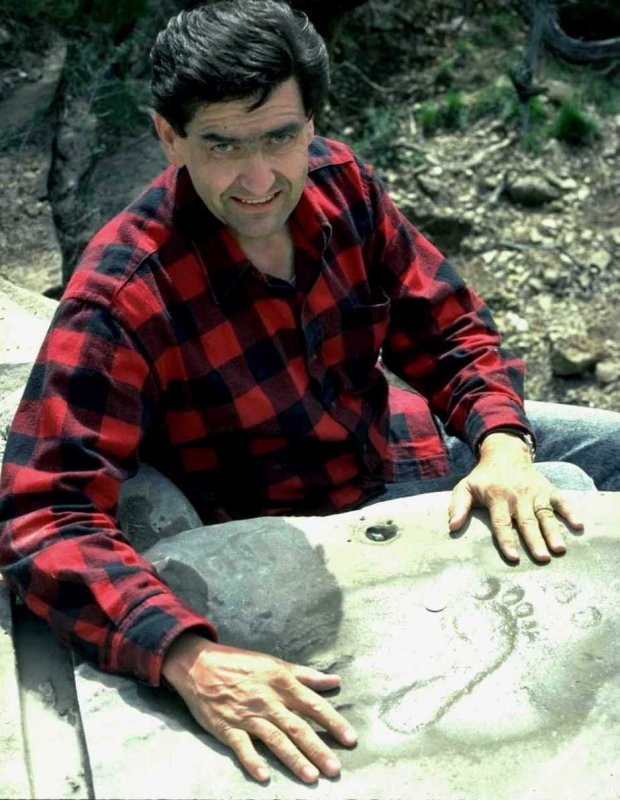Mystery Of The 290-Million-Year-Old Zapata Footprint In New Mexico
Jan Bartek - AncientPages.com - Fossilized footprints are often a subject of heated debates, especially if they are millions of years old and you cannot determine who made them.
In New Mexico, an extraordinary track is made in the mud. It's known as the Zapata footprint, and it is estimated "someone" made it about 290 million years ago.

The strange Zapata footprint is believed to be 290 million years old. Credit: Footprints in stone
Did human-like beings walk the Earth millions of years ago?
Is it a human footprint, or did a long-gone extinct animal make it? What did Earth look like 290 million years ago?
It was a time when the Earth's continents were fused in the supercontinent Pangea. Pangea broke into smaller continents in the Triassic period when dinosaurs first evolved. All plants and animals in those days would be unrecognizable to us.
The Zapata footprint was discovered many years ago by a hunter who informed his friend Don Shockey about the unusual find. Shockey, who knew about archaeology and anthropology, decided to investigate the footprint in the wilderness of New Mexico. He gathered a science team consisting of several experts. Two of the team's participants were Dr. Don Patton and Dr. Carl Baugh.

Stunning View Of What Supercontinent Pangea Looks Like Mapped With Modern Borders - Read More
Dr. Patton was an experienced geologist who had worked in several countries investigating fossils and participated in dinosaur excavations in Colorado, Texas, Wyoming, and Canada.
Dr. Baugh is the discoverer and excavation director of sixteen dinosaurs, including Acrocanthosaurus in Texas and Diplodocus in Colorado.
With such experienced science members, there should be an excellent chance to determine what kind of creature had left the footprint. The investigations should have been easy, but it wasn't due to several obstacles researchers encountered.
Soon after the science team obtained a mining permit to excavate in the area where the track was located, a local armed landowner threatened them for trespassing private land, claiming they were on this private land.

Examination of the Zapata fooprint. Credit: Footprints in stone
Shockey and his team showed the angry man their permission to excavate at the site and explained this was the BLM (Bureau of Land Management) property. Unfortunately, the landowner had a different opinion and told them to leave immediately. The team managed to take some photographs, but researchers were forced to interrupt the documentation, and they left the place in a hurry.
From an archaeological point of view, this was a tragedy because the hunter who had originally reported the discovery "had also reported that he had seen several other human footprints in the rock around the same area and showed Dr. Patton several photographs to validate his story." 1
According to Dr. Patton, the Zapata footprint is exceptionally shallow, making it very difficult to photograph.
So, who made the Zapata footprint? A majority will say humans did not exist millions of years ago. Could the Zapata footprint belong to a bipedal dinosaur? Maybe it can, but as we said at the beginning of this article, this happened during the age of Pangea, and scientists have concluded dinosaurs inhabited the world for some 160 million years. It means the Zapata footprint predates the dinosaurs.
Strange tracks in rocks have been found before, and they often pose a challenge to our historical timelines.
Some years ago, scientists discovered a set of controversial human-like footprints on Crete. These tracks are now putting the theory of human evolution to the test.
"The footprints are about 5.7 million years old from Trachilos in western Crete and have an unmistakably human-like form. It is especially true of the toes. The big toe is similar to our own in shape, size, and position. It is also associated with a distinct 'ball' on the sole, which is never present in apes." 2
Is it possible humans appeared much earlier than previously thought, or did unknown human-like beings leave behind footprints scientists cannot identify?
Written by Jan Bartek - AncientPages.com Staff Writer
Updated on April 4, 2023
Copyright © AncientPages.com All rights reserved. This material may not be published, broadcast, rewritten or redistributed in whole or part without the express written permission of AncientPages.com
Expand for referencesMore From Ancient Pages
-
 Unexplained Phenomenon In East Anglia – Ancient Mystery Deepens As More Unusual Sightings Are Reported – Part 2
Featured Stories | Jun 1, 2018
Unexplained Phenomenon In East Anglia – Ancient Mystery Deepens As More Unusual Sightings Are Reported – Part 2
Featured Stories | Jun 1, 2018 -
 Undiscovered Neanderthal Artifacts From The Ice Age Are Submerged Below The Waves Of The English Channel
Archaeology | Nov 23, 2022
Undiscovered Neanderthal Artifacts From The Ice Age Are Submerged Below The Waves Of The English Channel
Archaeology | Nov 23, 2022 -
 Young Boy Finds A Huge Tooth From A Prehistoric Shark In South Carolina
Archaeology | Sep 3, 2022
Young Boy Finds A Huge Tooth From A Prehistoric Shark In South Carolina
Archaeology | Sep 3, 2022 -
 What Can The 3D Reconstruction Of The Principia At Novae Reveal About Roman Propaganda?
News | Sep 16, 2023
What Can The 3D Reconstruction Of The Principia At Novae Reveal About Roman Propaganda?
News | Sep 16, 2023 -
 Was Tintagel Castle A Fortress Used By Iconic Hero King Arthur?
Featured Stories | Jul 12, 2022
Was Tintagel Castle A Fortress Used By Iconic Hero King Arthur?
Featured Stories | Jul 12, 2022 -
 Skaftö Wreck’s Cargo Gives New Answers About 15th Century Trade Routes
Archaeology | Oct 25, 2022
Skaftö Wreck’s Cargo Gives New Answers About 15th Century Trade Routes
Archaeology | Oct 25, 2022 -
 Milk Enabled Massive Steppe Migration
Archaeology | Sep 15, 2021
Milk Enabled Massive Steppe Migration
Archaeology | Sep 15, 2021 -
 Ancient Mosaic Floor Decorated With Colorful Floral Designs Re-Uncovered After 40 Years
Archaeology | Mar 25, 2023
Ancient Mosaic Floor Decorated With Colorful Floral Designs Re-Uncovered After 40 Years
Archaeology | Mar 25, 2023 -
 Large Previously Unknown Roman City Discovered At The Foot Of The Pyrenees
Archaeology | Jul 16, 2022
Large Previously Unknown Roman City Discovered At The Foot Of The Pyrenees
Archaeology | Jul 16, 2022 -
 Ancient Roman Altarpieces Deciphered And New Roman Goddess Uncovered In The Netherlands
Archaeology | Jun 18, 2024
Ancient Roman Altarpieces Deciphered And New Roman Goddess Uncovered In The Netherlands
Archaeology | Jun 18, 2024 -
 Mystery Of The Forgotten Explorers And Ancient Artifacts That Re-Write History Of North And South America
Civilizations | Apr 13, 2020
Mystery Of The Forgotten Explorers And Ancient Artifacts That Re-Write History Of North And South America
Civilizations | Apr 13, 2020 -
 Rare Gold Foils Found In Ancient Egyptian Tombs At Tel El-Deir In New Damietta
Archaeology | Jul 24, 2024
Rare Gold Foils Found In Ancient Egyptian Tombs At Tel El-Deir In New Damietta
Archaeology | Jul 24, 2024 -
 Old Kingdom Of Alashiya And City Of Enkomi With Roots On The Island Of Cyprus
Civilizations | Mar 1, 2018
Old Kingdom Of Alashiya And City Of Enkomi With Roots On The Island Of Cyprus
Civilizations | Mar 1, 2018 -
 Lyman Lake Petroglyphs And Famous Kokopelli-Flute Player Left By Ancestors Of The Hopi Indians
Civilizations | Nov 26, 2018
Lyman Lake Petroglyphs And Famous Kokopelli-Flute Player Left By Ancestors Of The Hopi Indians
Civilizations | Nov 26, 2018 -
 Incredible Trove Of 100,000 Ancient Coins Tied Together In Bundles Uncovered In Japan
Archaeology | Nov 13, 2023
Incredible Trove Of 100,000 Ancient Coins Tied Together In Bundles Uncovered In Japan
Archaeology | Nov 13, 2023 -
 Non-Invasive Radar Will Search King Tutankhamun’s Tomb For Nefertiti’s Hidden Crypt
Civilizations | Sep 24, 2015
Non-Invasive Radar Will Search King Tutankhamun’s Tomb For Nefertiti’s Hidden Crypt
Civilizations | Sep 24, 2015 -
 Rare 500-Year-Old Wreck From Missing Ship Samson Discovered In Central Stockholm, Sweden
Archaeology | Dec 20, 2019
Rare 500-Year-Old Wreck From Missing Ship Samson Discovered In Central Stockholm, Sweden
Archaeology | Dec 20, 2019 -
 On This Day In History: Battleship USS Maine Explodes And Sinks – On Feb 15, 1898
News | Feb 15, 2017
On This Day In History: Battleship USS Maine Explodes And Sinks – On Feb 15, 1898
News | Feb 15, 2017 -
 Ancient Board Game Mancala Can Unlock Cutting-Edge Physics Discoveries
Artifacts | Sep 30, 2023
Ancient Board Game Mancala Can Unlock Cutting-Edge Physics Discoveries
Artifacts | Sep 30, 2023 -
 A Graffiti Inscription With The Name Of Knight Adrian von Bubenberg – Found On Mount Zion In Jerusalem
Archaeology | Nov 30, 2022
A Graffiti Inscription With The Name Of Knight Adrian von Bubenberg – Found On Mount Zion In Jerusalem
Archaeology | Nov 30, 2022
